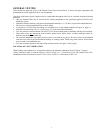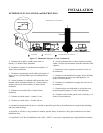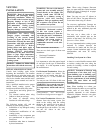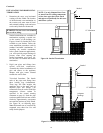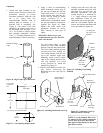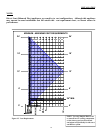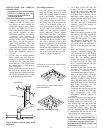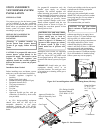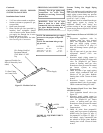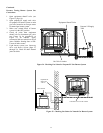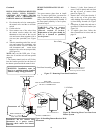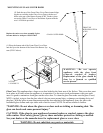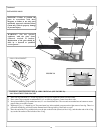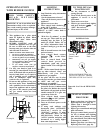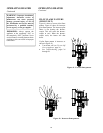
STOVE AND DIRECT-
VENT BURNER SYSTEM
INSTALLATION
CHECK GAS TYPE
Use proper gas type for the burner system
you are installing. If you have conflicting
gas types, do not install burner system. See
dealer where you purchased the stove and
burner system for proper burner system
according to your gas type.
INSTALLING GAS PIPING TO
STOVE/BURNER SYSTEM
LOCATION
Installation Items Needed
Before installing stove and burner system,
make sure you have the items listed below.
• External regulator (supplied by
installer)
• Piping (check local codes)
• Sealant (resistant to propane/LP gas)
• Equipment shutoff valve *
• Test gauge connection *
• Sediment trap
• Tee joint
• Pipe wrench
• Approved flexible gas line with gas
connection (if allowed by local codes)
(not provided)
* An CSA design-certified equipment
shutoff valve with 1/8" NPT tap is an
acceptable alternative to test gauge
connection. Purchase the CSA design-
certified equipment shutoff valve from your
dealer.
Warning: A qualified installer or
service person must connect burner
system to gas supply. Follow all local
codes.
CAUTION: For propane/LP units, never
connect burner system directly to the
propane/LP supply. This burner system
requires an external regulator (not
supplied). Install the external regulator
between the burner system and propane/
LP supply.
For propane/LP connections only, the
installer must supply an external
regulator. The external regulator will
reduce incoming gas pressure. You must
reduce incoming gas pressure to between
11 and 14 inches of water. If you do not
reduce incoming gas pressure, burner
system regulator damage could occur.
Install external regulator with the vent
pointing down as shown in Figure 30.
Pointing the vent down protects it from
freezing rain or sleet.
Installation must include an equipment
shutoff valve, union, and plugged 1/8"
NPT tap. Locate NPT tap within reach
for test gauge hook up. NPT tap must be
upstream from burner system (see Figure
31).
IMPORTANT: Install main gas valve
(equipment shutoff valve) in an
accessible location. The main gas valve
is for turning on or shutting off the gas to
the appliance.
CAUTION: Use only new, black
iron or steel pipe. Internally-tinned
copper tubing may be used in
certain areas. Check your local
codes. Use pipe of 1/2" diameter or
greater to allow proper gas volume
to burner system. If pipe is too
small, undue loss of pressure will
occur.
Check your building codes for any special
requirements for locating equipment
shutoff valve to stoves.
Apply pipe joint sealant lightly to male
threads. This will prevent excess sealant
from going into pipe. Excess sealant in
pipe could result in clogged burner
system valves.
We recommend that you install a
sediment trap/drip leg in supply line as
shown in Figure 31. Locate sediment trap/
drip leg where it is within reach for
cleaning. Install in piping system between
fuel supply and burner system. Locate
sediment trap/drip leg where trapped
matter is not likely to freeze. A sediment
trap traps moisture and contaminants.
This keeps them from going into burner
system gas controls. If sediment trap/drip
leg is not installed or is installed wrong,
burner system may not run properly.
CAUTION: Use pipe joint sealant
that is resistant to liquid petroleum
(LP) gas.
From Gas Meter
(5" W.C.**to
10.5" W.C. Pres-
sure)
Approved Flexible Gas
Hose (if allowed by local
codes)
Gas Control
CSA Design-Certified
Equipment Shutoff
Valve With 1/8" NPT
Tap
Tee Joint
Pipe Nipple
Cap
Sediment
Trap
3" Minimum
Figure 31– Gas Connection
Propane LP supply
tank
External Regulator
Vent Point-
ing Down
Figure 30– External Regulator with Vent Pointing Down (LP Only)
15



